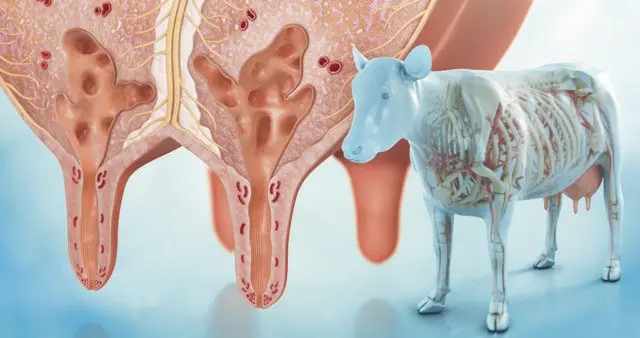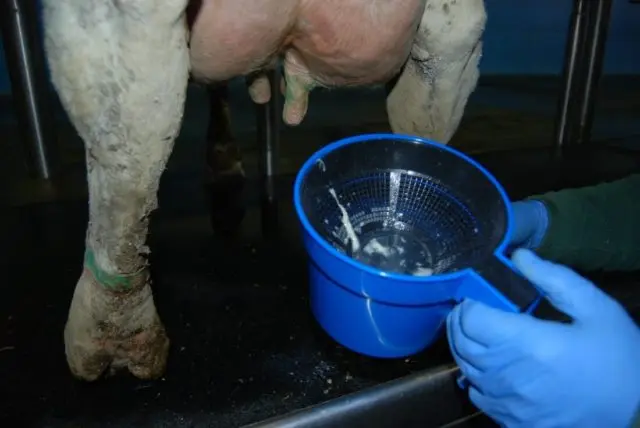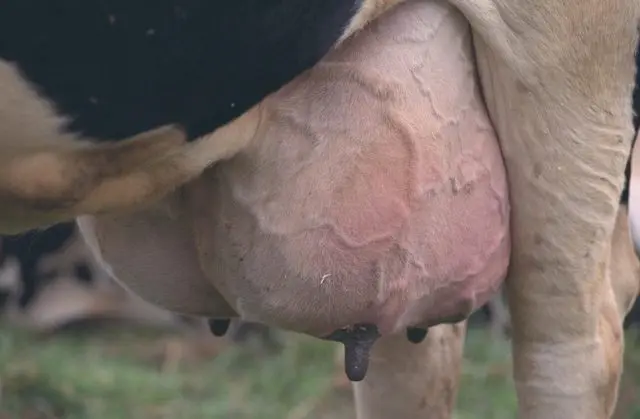Contents
Catarrhal mastitis in cows is quite common. The first signs of catarrh of the mammary gland in cows are difficult to determine even for an experienced specialist. To identify this disease, it is necessary to study the main signs and pathogenesis of the disease.
Pathogenesis of catarrhal mastitis in cows
Catarrhal mastitis in cows is most often the result of an inflammatory process on the skin of the nipples and the epithelium of the nipple canal as a result of injury to the udder, damage to the mucous membrane during rough milking. Pathogenic microorganisms enter the milk passages and the cistern through the nipple canal, less often by the hematogenous and lymphogenous route.

Catarrhal mastitis in cows can occur:
- in acute form lasting up to 10 days;
- in subacute form lasting up to three weeks;
- in a chronic form lasting more than a month.
The pathogenesis of catarrhal mastitis in cows, which occurs in an acute form, is characterized by degeneration, damage to the glandular and integumentary epithelium of the mammary gland with the formation of exudate and the migration of leukocytes to the inflammation site.
With untimely treatment, the disease becomes subacute or chronic. The inflammatory process spreads and affects the alveoli of the mammary gland. The epithelium accumulates toxic waste products of pathological microorganisms – exo- and endotoxins. Metabolic products lead to the death of cells of the glandular epithelium. Casein flakes and mucus impurities appear in cow’s milk. A few days later, obstruction of the milk passages is noted in the affected lobes of the mammary gland due to the formation of retention cysts and the growth of connective tissue.
Etiology of catarrhal mastitis in cows
The causes of catarrhal mastitis in cattle are:
- violation of zoohygienic norms and rules for keeping dairy cows;
- udder and teat injuries;
- non-observance of sanitary rules during milking;
- violation of the technique of machine and manual milking.
Dairy cows must not be kept in damp, unventilated premises with temperature violations. Stalls and boxes must be cleaned of manure daily and bedding renewed. It is also unacceptable to express milk from cows with mastitis on the floor and bedding – this can provoke infection of the udder of healthy animals and relapse of the disease.
Before milking, it is necessary to inspect the animal for damage. Injured areas must be disinfected. Injuries to the udder are often the result of crowded keeping of animals, so the premises for keeping and walking the dairy herd must be spacious.
Catarrh of the tank and milk passages often occurs when the rules for machine milking of cattle are violated, rough manual milking, causing udder injuries. Catarrhal mastitis in cows often occurs in the first weeks of lactation. Often this form of inflammation of the mammary gland develops in first-calf heifers.
Clinical signs of catarrhal mastitis in cows
The first clinical signs of catarrhal mastitis in cows with inflammation of the milk passages and cistern can be seen on the 3-4th day. On palpation of the lower part of the udder quarter and the base of the nipple, a pea-sized induration can be felt. At the beginning of the inflammatory process, milk expressed from the affected quarter has a heterogeneous watery texture with flakes and crumbly clots of casein. With catarrhal mastitis in cows, the milk becomes yellowish or bluish. During subsequent milking, the milk has a normal uniform consistency and color.

By 3-4 days, in the first portions of the secret, you can notice curdled clots that fill the milk ducts and make it difficult to express. The cow does not experience pain during udder palpation and milking, the general condition of the animal does not cause concern. Milk production with catarrhal mastitis in cows may slightly decrease.
Наиболее опасная форма катарального мастита у коров – воспаление альвеол. Альвеолярное воспаление сопровождается ухудшением состояния животного, аппетита и повышением температуры до 40-41°С, также учащается пульс и дыхание. Пораженная четверть или доля вымени незначительно увеличивается в объеме. Отмечается повышение местной температуры, гиперемия и болезненность при пальпации вымени. Молочный секрет имеет неоднородную консистенцию с примесями слизистых сгустков, хлопьев с сероватым или желтым оттенком на протяжении всего доения.
Treatment of catarrhal mastitis in cows
In the treatment of catarrhal mastitis in cows, hormonal, painkillers and antibiotics are used. Before starting to treat catarrhal mastitis in cows, the animal should be limited to feeding juicy, concentrated feed, as well as watering.
The affected part of the udder, first of all, must be freed from milk infected with pathogenic microorganisms and their metabolic products. During the day, it is necessary to milk the inflamed part of the udder 2-3 times manually. Before milking, it is necessary to carry out a light massage of the udder towards the teats.
The mucous clots accumulated in the milk passages and the cistern are liquefied by introducing 40-50 ml of a warm soda solution (1-2%), followed by decanting for 15 minutes. 5-7 minutes before milking (non-pregnant cows), you can enter 25-30 IU of oxytocin (subcutaneously) – this will allow for the complete removal of the affected milk secret from the areas of the milk lobe. After pumping milk into the affected part of the udder through the teat canal, it is necessary to inject 8-10 ml of the Mastisan emulsion (A, B or E), heated to 36-38 ° C, once or twice a day.
Prognosis and possible complications
With timely diagnosis and proper treatment of the disease in the initial stage (5-7 days), the prognosis is favorable. The milk production of an animal after catarrhal mastitis, as a rule, is restored.

On the 10-15th day, the inflammatory process, if left untreated, passes into catarrh of the alveoli of the mammary gland. The formation of multiple nodes and cysts leads to udder atrophy and obliteration of the milk passages. In this case, milk production is not restored to the original.
Первые симптомы катарального мастита у коров особенно на начальной стадии сложно выявить даже ветспециалисту, поэтому лечение данного заболевания зачастую назначают уже при проявлении очевидных признаков и осложнений. Катаральная форма мастита чаще возникает в лактационный период. В сухостойный период и период запуска заболевание возникает реже. В сухостойный период определить наличие заболевания очень сложно, а в начале следующей лактации патологический процесс обостряется и проходит в клинической форме.
Prevention of catarrhal mastitis of cattle
Чтобы исключить вероятность возникновения данного заболевания, необходимо следовать основным мерам профилактики:
- keep the stalls and other places where the dairy cattle are kept clean (cleaning and disinfection);
- observe the temperature regime, avoid drafts;
- comply with sanitary standards for machine and manual milking of cows;
- timely and gradually launch cows before calving;
- exclude crowded keeping of animals in order to avoid injuries to the udder;
- pump the first portions of milk into special containers with a mesh – this will help diagnose signs of mastitis and prevent infected milk secretion from getting on the floor.
For early detection of catarrhal and other types of mastitis in cows, it is necessary to regularly inspect the udder and monitor the animal, which, in the event of a disease, will allow the veterinarian to compile a medical history and prescribe treatment based on the data obtained.
Conclusion
Catarrhal mastitis in cows, like other forms of this disease, is dangerous because with delayed treatment, part of the animal’s mammary gland may completely lose its ability to produce milk. Timely treatment and prevention of the disease, as well as compliance with zoohygienic standards for keeping dairy animals will help to avoid the consequences of catarrhal mastitis.









